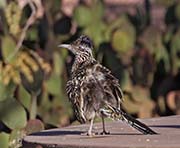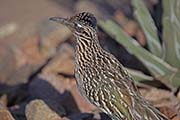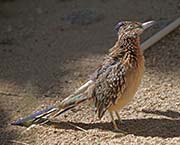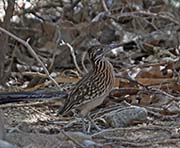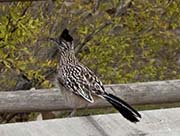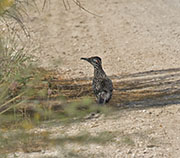Greater Roadrunner - Geococcyx californianus
| Length | |
| Wingspan | |
| Weight | |
| Clutch Size | |
| Chicks at birth | |
| IUCN Conservation Status | |
Continents: |
The Greater Roadrunner is the largest cuckoo in North America and is also the state bird of New Mexico. They get their name from their running ability. While they can fly, they can only fly for short distances. The Greater Roadrunner head, neck, back and wings are dark brown, black and are streaked with white. The breast is mostly white. They have a bushy crest of black feathers and a long black tail. They bill is long and thick with a hooked tip.
Diet: Roadrunners eat most small prey. This includes snakes, large insects, scorpions, spiders, lizards, rodents, small birds, and a small amount of fruit and seeds. They use their speed (up to 15 mph) to capture prey. If the prey is large, they will use their strong bills to repeatedly beat the prey against a rock or the ground.
Roadrunners get most of their moisture from the food they eat but will drink water if available.
Courtship: The pairing of Greater Roadrunners is monogamous and seems to be a life bond. The male courtship display includes bowing, prancing, tag wagging and offering food to the female.
Nesting: Greater Roadrunners lay 3-6 eggs on a platform of sticks under a cactus or bush. They may produce more than one brood in a year. The eggs are incubated as they are laid. In lean years, later born chicks may not survive. Both parents incubate and feed the young.
Habitat and Range: Greater Roadrunners are found in desert and shrubby country in the southwestern U.S. and northern Mexico. They are territorial and they seem to be expanding in the U.S. by moving north and east from the southwest.
Plumage/Molt: No information.
Migration: Roadrunners are a non-migratory bird.
Tongue/feet: The feet are zygodactyl which means there are two toes pointing forward and two toes pointing backward.
Bibliography:
- Cornett, James W., The Roadrunner,Nature Trails Press, 2001
- Kaufman, Kenn, Lives of North American Birds,Houghton Mifflin Company, 1996
